The quest to conquer the other North Pole
By Camila RuzBBC News Magazine
19 October 2015
From the sectionMagazine
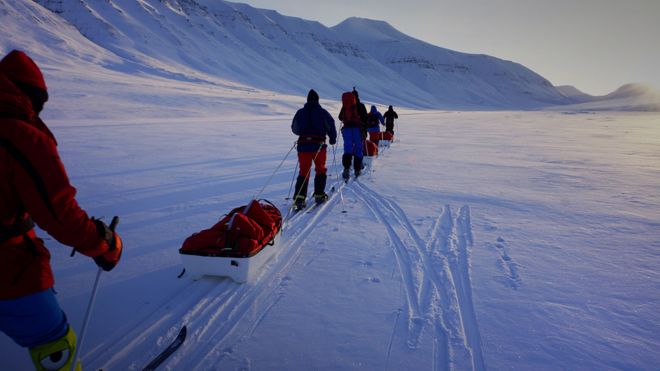 Image copyrightIce-warrior.com
Image copyrightIce-warrior.comIn today's Magazine
France's migrant 'cemetery' in Africa
How China guards the Xi creation myth
Inside Iran’s Revolutionary Courts
The polar bears are coming to town
In the centre of the Arctic Ocean there is a Pole that has yet to be conquered. Now a British team is planning a journey of more than 1,000km (800 miles) to be the first to reach the loneliest place on the ice.
The Arctic can be an unforgiving place, especially at its most remote location. The Northern or Arctic Pole of Inaccessibility marks the place that is the hardest to reach. It's the point that is furthest from any speck of land, about 450km (280 miles) from the geographic North Pole.
It can be reached by trekking across the thick layer of ice that covers an ocean up to 5,500m (16,400ft) deep. Temperatures here can reach -50C in winter and it's dark from October to March.
Next year's expedition will be Jim McNeill's third attempt on the Pole. The explorer's first two expeditions did not quite go according to plan. A flesh-eating bacterial infection kept him at base camp the first time.

On the second attempt in 2006, he fell through the ice just before a storm hit. "The next three days were horrendous," he says. "The three-and-a-half metre high ice I was on was cracking continually so sleep became a real problem."
McNeill had made it about 270km (168 miles) north of the last landfall, but with the ground disintegrating around him, he was forced to call off the attempt.
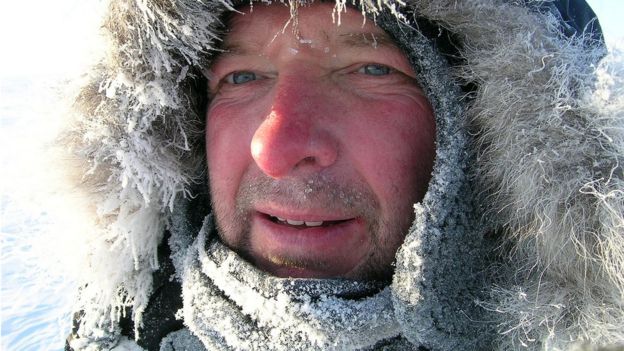 Image copyrightIce-warrior.comImage captionJim McNeill is leading the expedition
Image copyrightIce-warrior.comImage captionJim McNeill is leading the expeditionOn the opposite end of the earth in Antarctica, it's the point that is furthest away from the coastline. Explorers have travelled to a few different locations for the Southern Point of Inaccessibility because of disagreements about where the coast ends.
But tradition says that it was first reached in the late 1950s by a Soviet Antarctic Expedition. The team built a research station there, topped by a bust of Russian revolutionary Lenin. When it was re-visited in 2007, the hut had been buried and only the statue could be seen perched on the snow.
 Image copyrightStein Tronstad/Norwegian Polar InstituteImage captionA bust of Lenin marks the Southern Pole of Inaccessibility
Image copyrightStein Tronstad/Norwegian Polar InstituteImage captionA bust of Lenin marks the Southern Pole of InaccessibilityBut while teams have raced to the Southern Point of Inaccessibility, the Arctic Pole proved elusive. The Australian polar explorer Hubert Wilkins was thought to have flown over the location in 1927.
British explorer Wally Herbert thought he had reached it on foot during his 5,900km (3,700 miles) journey across the Arctic Ocean in the 1960s. But the Pole was in the wrong place.
It was McNeill who first suspected that the coordinates were incorrect. A group of scientists followed up his hunch, using modern satellite data to get a clearer picture of the area.
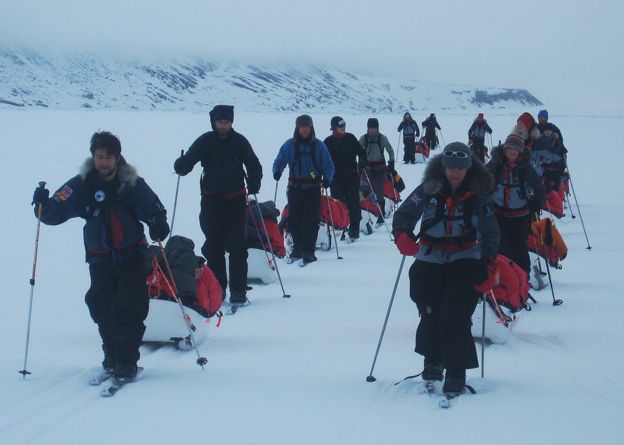 Image copyrightIce-warrior.com
Image copyrightIce-warrior.com"The coastline in the Arctic believe it or not, as late as the 90s and early 2000s still had some big errors due to incorrect mapping from many years ago," says Ted Scambos from the US National Snow and Ice Data Center in Boulder, Colorado, who took part in the study.
Jump media player
Media player help
Out of media player. Press enter to return or tab to continue.Media captionJim McNeill talks about the expedition on Radio 5live
What they discovered was that the Northern Pole of Inaccessibility was 214km (133 miles) away from the old point. It should have been an easy mistake to spot, says Gareth Rees, from the Scott Polar Research Institute, who helped calculate the new location.
If you imagine drawing the largest circle you could possibly draw in any specified ocean, the pole of inaccessibility is at the centre, he says. It will touch land in three places so there are three locations that define it. However, the old maps only ever gave two locations, so they were wrong. "It's a mystery which we haven't resolved."
The Conquest of the North Pole
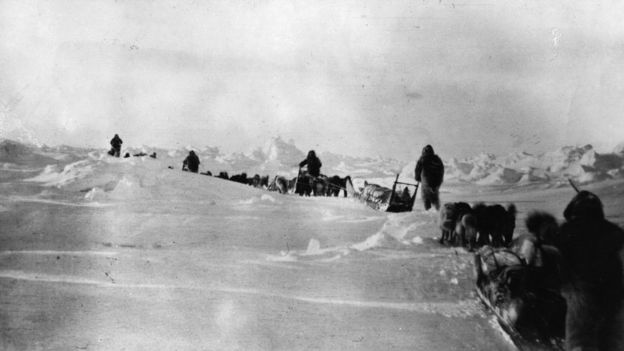 Image copyrightGetty Images
Image copyrightGetty ImagesUS explorer Robert Peary (1856-1920) claimed to have reached the North Pole in a 1909 expedition (pictured), but many now dispute the accuracy of his navigation
First verified journey carried out by Roald Amundsen of Norway and Lincoln Ellsworth of US; they flew over the Pole in the airship Norge in 1926
First explorers to have verifiably set foot on the Pole were a 24-strong Soviet party taking part in the Sever-2 expedition in 1948
First confirmed conquest of the North Pole on foot was accomplished by a British team led by explorer Wally Herbert (1934-2007) in 1969
The new coordinates were announced in 2013. No-one has consciously made it to the Pole so far. The sheer scale of the challenge will be off-putting for some.
"The ice can get thrown up into great piles of ridges," says Nick Cox from the British Antarctic Survey and station manager for the UK Arctic Research Station. "There is always the chance that you are going to reach leads, which are open patches in the ice, and there's always the chance that you might fall through."
It's a different challenge to its sister pole in the south. "It's a very long cold cross-country ski in the Antarctic but in the Arctic it's a bit of an obstacle course," explains Scambos.
This has not daunted McNeill from planning his third attempt. Next year, a team of volunteers with his Ice Warrior Project will set off with their Qajaqs - sledges crossed with canoes.
 Image copyrightIce-warrior.com
Image copyrightIce-warrior.comAll going well, it will take them 80 days to reach their goal. They will be measuring the ice they cross on the way to help gather information about how it's breaking up. The team will be also counting polar bears, although it's not clear how many there will be so far into the ice.
"I wouldn't really call it a barren place," says Donatella Zona, an Arctic ecologist at the University of Sheffield. But not enough is known about Arctic biodiversity, partly because it's so difficult for researchers to do their work there. "It's very hard. There are months of complete darkness and it's -40C to -50C," she explains.
 Image copyrightIce-warrior.com
Image copyrightIce-warrior.comThe race to study the Arctic as the climate changes is becoming more urgent. Some argue that the Point of Inaccessibility might not be so unreachable for long. There are various predictions about how soon it will be before there is no summer ice on the Arctic Ocean, making it easier to navigate by ship.
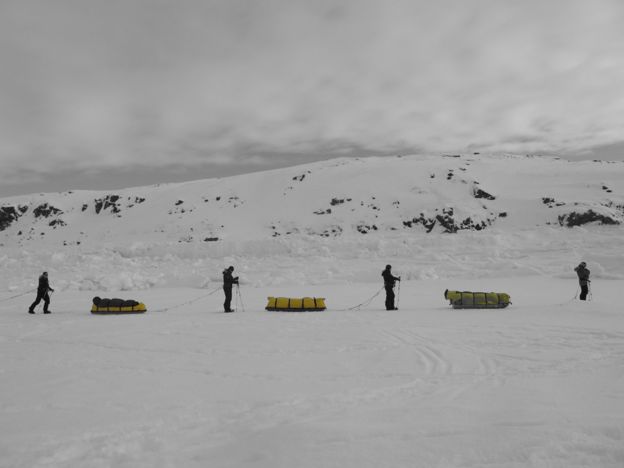 Image copyrightIce-warrior.com
Image copyrightIce-warrior.comBut changes to the ice are already making the Pole more dangerous to reach on foot. The ice is thinning and the terrain is becoming rougher. "Increasingly I think you're going to find that people won't even attempt to do things like cross the Arctic," says Scambos.
McNeill and his team will be starting their journey in winter in the hope that they can cross the ice before it begins to crack and loosen. But they will need to hurry through the dark because their route to the Pole of Inaccessibility is melting away.
More from the Magazine
Sem comentários:
Enviar um comentário